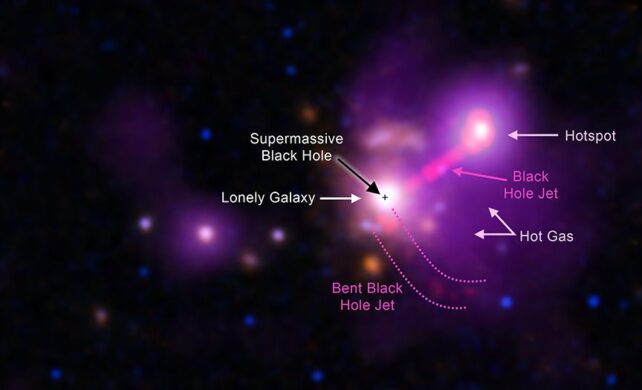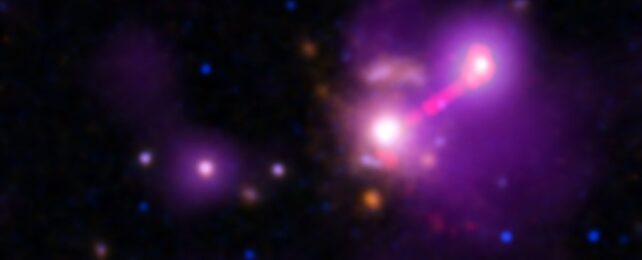It's the classic social faux pas. You're in a happy clique, surrounded by all your friends – and one by one, you subsume them, absorbing them into yourself, until you're all alone, a grotesque agglomeration alone in what was once a crowded environment.
That seems to be what happened to a galaxy 9.2 billion years ago, scientists have determined. A galaxy in the relatively early Universe named 3C 297 is mysteriously all alone – even though its environment suggests that it should be part of a cluster of at least 100 galaxies, some of which should be the size of the Milky Way.
The fact that 3C 297 is all alone suggests that something else happened to all those other galaxies.
"It seems that we have a galaxy cluster that is missing almost all of its galaxies," says astronomer Valentina Missaglia of the University of Torino in Italy. "We expected to see at least a dozen galaxies about the size of the Milky Way, yet we see only one."
Data on the environment surrounding 3C 297 came from the Chandra X-ray Observatory, which studies high-energy radiation from powerful sources across the cosmos. The galaxy itself is a source of this radiation; it hosts a quasar, an active galactic nucleus containing a supermassive black hole guzzling down material at such a furious rate that it blazes with some of the brightest light in the Universe.
Quasars often emit beams of plasma from the polar regions of the supermassive black hole at their core, blasting jets of matter into space at speeds close to that of light in a vacuum. These are created out of the material swirling around the black hole's event horizon, which is swept up and accelerated along magnetic field lines toward the poles and launched into intergalactic space.
3C 297 has such jets, and this is where things around the galaxy get interesting. Data from Chandra and the Karl G. Jansky Very Large Array picked up several signs that the jets travel through an intergalactic medium associated with a galaxy cluster, known as an intracluster medium.

One of the jets is bent in a way that suggests it is interacting with gas in an intracluster medium. The other jet has created an X-ray source 140,000 light-years from the galaxy, suggesting that it has slammed into gas, causing it to heat up and emit X-rays. In addition, Chandra data suggests that there are large quantities of hot gas in the space around 3C 297.
All three characteristics taken together suggest that there should be other galaxies gravitationally bound up with 3C 297 as an interacting cluster.
Indeed, there do appear to be other galaxies in the same patch of sky as the distant quasar galaxy. So Missaglia and her colleagues turned to data from the optical and infrared Gemini Observatory in Hawaii for a better understanding of the space around 3C 297.
This data revealed that the 19 galaxies are only close to 3C 297 in two dimensions; their distances from us are vastly different from that of 3C 297, and they don't belong to the same region of space. The peculiar lonely quasar galaxy is indeed all alone.
These clues suggest that 3C 297 is the result of a giant cluster merger, making it what is known as a "fossil group"; the remains of a cluster combined in one single object.
"We think the gravitational pull of the one large galaxy combined with interactions between the galaxies was too strong, and they merged with the large galaxy," explains astronomer Juan Madrid of the University of Texas. "For these galaxies apparently resistance was futile."
We've seen other clusters of galaxies in the process of these mergers, and traced the gas filament "superhighways" they travel on their path to coalescence. We've even seen other fossil groups; however, the other fossil groups identified to date have all been spotted closer to us, which means we're observing them later in the Universe's history.
3C 297 is the earliest fossil group astronomers have identified yet, which means that these mergers can occur much earlier in the Universe's lifespan than it was thought they could.
This means that we may need to rethink how the complete mergers of galaxy clusters unfold.
"It may be challenging to explain how the Universe can create this system only 4.6 billion years after the Big Bang," says astronomer Mischa Schirmer of the Max Planck Institute for Astronomy in Germany. "This doesn't break our ideas of cosmology, but it begins to push the limits on how quickly both galaxies and galaxy clusters must have formed."
Given the large number of things we're discovering in the early Universe that we thought couldn't be there, though, perhaps 3C 297 is not such an oddball.
The research has been published in The Astrophysical Journal.
